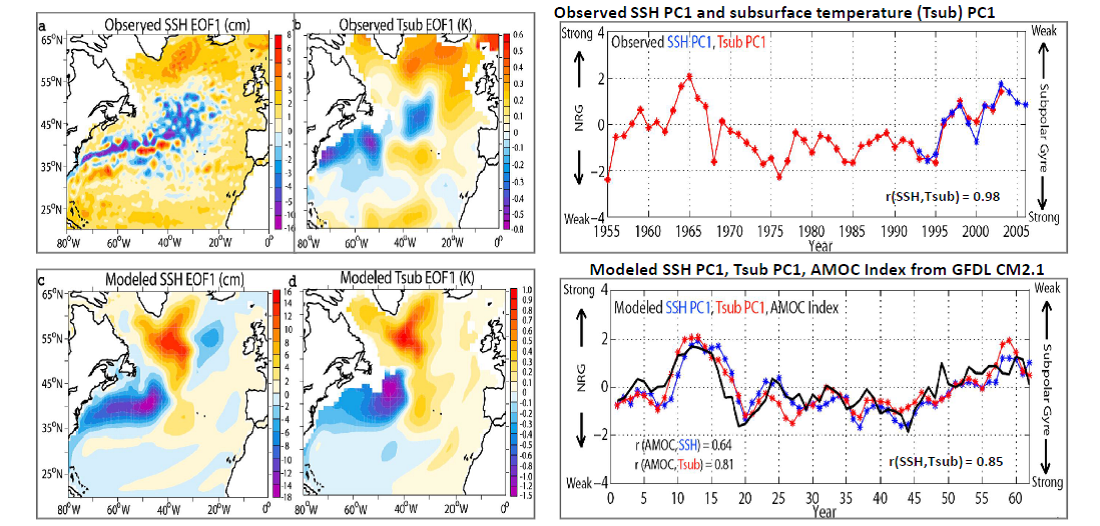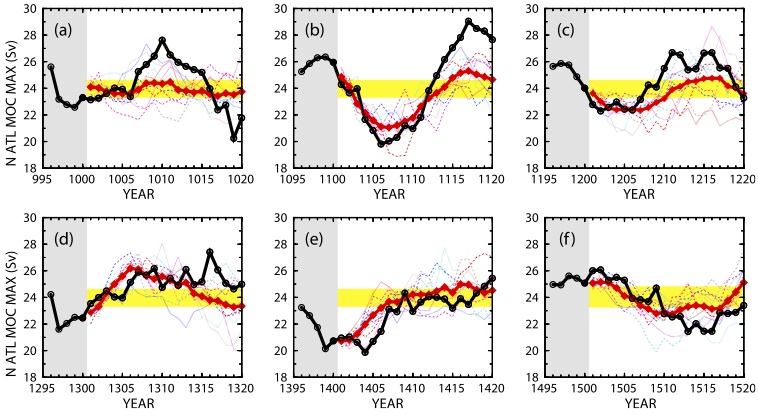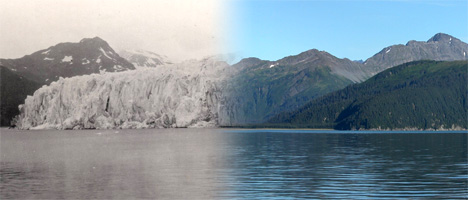Multidecadal Climate Changes
Large multidecadal variations referred to as the Atlantic Multidecadal Oscillation (AMO) or Atlantic Multidecadal Variability (AMV) have been observed in the Atlantic sea-surface temperatures (SST). These oceanic variations are associated with large-scale global air-temperature anomalies far beyond the Atlantic region. While the AMV is thought to be mainly driven by natural variations, it is also influenced by external forcing including greenhouse gases, aerosols, and volcanoes. Depending on the phase of AMV, an enhanced or reduced large-scale warming could be observed in the future, in addition to the anthropogenic induced warming. Identifying the exact mechanisms behind AMV variations is crucial to provide reliable predictions of decadal changes. The meridional ocean heat transport in the Atlantic is dominated by the Atlantic Meridional Overturning Circulation, or AMOC. The AMOC is a large scale overturning circulation that transports heat from the South Atlantic to the North Atlantic high latitudes and can lead to a surface temperature pattern that mimics that of the AMV. The linkage between AMOC and AMV inspired the significant interest in observing AMOC variations and in properly representing it in climate models.
GFDL Research
GFDL scientists have explored the mechanisms causing AMV, its linkage with the AMOC and the climate impacts of AMV and their predictability. Highlights of GFDL research in this area are described below.
Mechanisms and Attribution of Atlantic Multidecadal Variability
Identifying the main drivers of the Atlantic Multidecadal Variability (AMV) is crucial for predicting how the Atlantic will evolve in the coming decades and the resulting global and regional climate impacts. Previous work suggested that atmospheric forcing and more specifically aerosols were a prime driver of AMV. However, observations of upper ocean heat content in the North Atlantic, the spatial pattern of multi-decadal SST changes, and the subpolar North Atlantic SSS refute this hypothesis. GFDL scientists and their collaborators have demonstrated that aerosol effects cannot account for the observed anti-correlation between detrended multi-decadal surface and subsurface temperature variations in the tropical North Atlantic (Zhang et al. 2013). These discrepancies cast considerable doubt about aerosol forcing driving the bulk of this multi-decadal variability.
Further, previous work by GFDL scientists showed that observed climate variations over the Atlantic Hurricane Basin’s main development region can be decomposed into a component attributable to radiative forcing changes and a component due to AMV. This suggested that the observed multidecadal anomalies of vertical shear and a simple index of maximum potential intensity for tropical cyclones are both dominated by AMV, consistent with multidecadal variations of Atlantic hurricane activity (Zhang and Delworth 2009). The observed changes in radiative forcing were shown to be unfavorable for Atlantic Hurricane activity.
GFDL work has also linked the mechanisms of AMV to coherent large-scale oceanic variations — that is, the variations of the AMOC, of the deep western boundary current (DWBC), of the northern recirculation gyre, and of the Gulf Stream path, involving salinity anomalies in the North Atlantic Ocean. In particular, a dipolar sea surface temperature anomaly (warming off the U.S. east coast and cooling south of Greenland) has been shown to be triggered by the Great Salinity Anomaly events several years in advance, providing a degree of long-term predictability of the AMV (Zhang and Vallis 2006).
Fingerprints of Multidecadal AMOC Variability
Both observations and the GFDL CM2.1 coupled model have been used to show that coherent variations exist between the AMV and the North Brazil Current (NBC) transport (Zhang D., Msadek, McPhaden and Delworth 2011). These results indicate that the NBC transport, which has been well observed over the past decades, is a good index for tracking AMOC variations, which are much more difficult to observe directly.
Other fingerprints of the AMOC have been previously identified by GFDL scientists. Multidecadal variations of observed tropical North Atlantic (TNA) SST are strongly anti-correlated with those of the observed TNA subsurface ocean temperature, with long-term trends removed. Therefore, the observed detrended multidecadal TNA subsurface temperature anomaly may be taken as a proxy for the past AMOC variability. Altimeter data is also highly correlated with instrumental subsurface ocean temperature data in the North Atlantic, both showing opposite signs between the subpolar gyre and the Gulf Stream path. Such a dipole pattern is a distinctive fingerprint of AMOC variability (Figure 1).
These fingerprints can be used to reconstruct the past AMOC multidecadal variations and monitor future AMOC variations. In particular, the recent slowdown of the subpolar gyre appears to be a part of a multidecadal variation indicating a strengthening of the AMOC.

Figure 1: The leading modes of SSH and subsurface temperature (Tsub) constitute a fingerprint of AMOC variations, and might be used as a proxy for the AMOC. It indicates the AMOC was weaker during the 70’s and 80’s, and stronger during the 60’s and end of the 20th century. It also suggests that the recent slowdown of the subpolar gyre is a multidecadal variation (adapted from Zhang, 2008).
Meridional Coherence/Propagation of AMOC Variability and Change:
To better understand how AMV propagates across the North Atlantic basin, from north to south, work has been done to identify the pathways of the AMOC. Because of these interior pathways, the AMOC has been shown to be meridionally coherent when using density instead of height as a coordinate. In addition, AMOC variations propagate with the advection speed in this region, therefore AMOC variations in the subpolar gyre lead those in the subtropical gyres by several years, providing some predictability to the associated sea surface temperature pattern.
This result has been shown to be robust across various degrees of ocean resolution of the GFDL models (Zhang et al. 2011). The use of high-resolution eddy-permitting ocean models also showed that a stronger and deeper-penetrating Nordic Sea overflow leads to a stronger and deeper AMOC, a contracted subpolar gyre, and hence more realistic pathways of the Gulf Stream and North Atlantic Current key to realistically representing the sea surface temperature off the North American east coast. These results are consistent with a previous observational study that linked the Gulf Stream path to the AMOC (Joyce and Zhang, 2010).
AMOC link to Meridional Heat Transport
The link between AMOC and poleward heat transport has motivated the need to observe the AMOC. However, direct and continuous observations of the AMOC and the associated heat transport only became available in 2004 through the RAPID MOCHA program, and solely at a specific location (26.5ºN). This new set of observations has provided a unique opportunity to identify the strengths and weaknesses of climate models in reproducing the observed AMOC structure and its variations.
The observed relationship between AMOC and Meridional Heat Transport (MHT) has been compared to simulations from two climate models, the GFDL CM2.1 and the National Center for Atmospheric Research CCSM4 models (Msadek et al. 2013). The observed linear relationship between MHT and AMOC at 26.5°N was shown to be realistically simulated by the two models mainly because of the overturning component of the MHT. However, while baroclinic geostrophic transport variability plays a larger role in controlling AMOC variations in observations, Ekman transport variability was dominant in the climate models. This GFDL-led study highlighted biases in the gyre heat transport that reduce the total heat transport, even when the overturning contribution is realistic. This points to the remaining challenges associated with understanding and simulating AMOC variations.
Global and Regional Climate Impacts of AMV
A number of observed climate anomalies across the world have been related to the AMV. Indeed, both observational data and modeling results have shown that the AMV can cause the observed multidecadal variations of India summer rainfall, Sahel summer rainfall, shifts in the precipitation patterns, and Atlantic Hurricane activity (Zhang and Delworth 2006, Zhang and Delworth 2005). In addition, the AMV can induce anomalous Northern Hemisphere mean temperatures similar in phase and magnitude to observed detrended temperatures. This suggests that variability in the Atlantic is a viable explanation for a portion of the multidecadal variability in the Northern Hemisphere mean temperature record (Zhang et al. 2007). Furthermore, the AMV can contribute to the Pacific variability and more specifically to changes in the Pacific Decadal Oscillation and the Pacific/North America pattern. Finally, the AMV has been shown to explain some of the recent Arctic variations. Indeed, an intensification of the AMOC is associated with a winter sea-ice decline in the Labrador, Greenland and Barents Seas similar to that observed, suggesting the possibility of a role of the AMOC in the recent Arctic sea-ice decline, in addition to anthropogenic greenhouse gas induced warming (Mahajan et al. 2011a).
Potential Predictability of Multidecadal AMOC Variations
Because of the societal importance of the climate impacts associated with the AMV and the AMOC, large efforts have been devoted at GFDL to investigate whether such variations could be predicted. Perfect model predictability experiments were used to investigate the potential predictability of the AMOC using the GFDL CM2.1 climate model (Msadek et al. 2010). These experiments showed that the AMOC is predictable on decadal time scales, with significant predictability up to 20 years for some specific initial conditions (Figure 2). The predictability of the AMOC was further connected to the predictability of AMOC fingerprints (identified by Zhang, 2008). This study showed that the AMOC fingerprints defined by characteristic patterns of sea surface height, subsurface temperature, and upper ocean heat content anomalies, have a potential predictability similar to the AMOC’s. Since there are longer observational records for these patterns than for direct measurements of the AMOC, this is a potentially promising method for monitoring AMOC variations, and assessing the predictability of the real climate system.

Figure 2: AMOC index in the CM2.1 control run (black) and in the ensemble predictability experiments (red). The six panels correspond to six different ocean initial conditions illustrating the state dependence predictability of the AMOC (Msadek et al. 2010).
From Predictability to Skillful Predictions of North Atlantic Decadal
Changes
The ability to realize this potential predictability in operational-like forecasts has been investigated using GFDL decadal climate predictions. The North Atlantic is among the few places where decadal climate variations are considered potentially predictable because of the key role of the AMOC and indeed, initialized predictions show larger skill than uninitialized projections solely in the North Atlantic (Goddard et al. 2013). GFDL contributed to the CMIP5 decadal predictions by running retrospective predictions using the CM2.1 coupled model initialized from the ECDA observational estimate (link to ECDA webpage), every year between 1961 and 2010. Parallel sets of multiple decades of hindcast experiments, for which the model is initialized from the climate observing system, or is only forced by radiative forcings, have been compared. A pattern similar to the AMV was found, characterized by an inter-hemisphere SST dipole, and predictable at decadal time scales (Yang et al. 2013). The decadal predictive skill primarily originates from initialization of multidecadal variations of northward oceanic heat transport in the North Atlantic.
In the same decadal prediction experiments, retrospective predictions of the abrupt warming that occurred in the North Atlantic subpolar gyre in the mid-1990s demonstrated great skill (Msadek et al. 2014). The predicted warming was associated with climate impact anomalies similar to those occurring during a positive phase of the AMV, i.e enhanced warming over the central U.S., wetter conditions over the Sahel and India, a northward shift of the ITCZ, and reduced Arctic sea-ice extent. Examination of the physical mechanisms responsible for the abrupt changes in the predictions indicates that initializing the AMOC was key to the successful predictions.
Statistical Predictions of AMV
In addition to the dynamical predictions described above, GFDL scientists and colleagues have developed a linear statistical predictive model of AMV by fitting a statistical auto-regressive model to the observed AMOC fingerprints and applying it to the assimilated subsurface temperature and altimetry SSH anomalies to make predictions. The statistical model predicted a weakening of AMOC strength over the last decade after its peak around 2005 (Mahajan et al. 2011b).
Related Links
Research Highlights
- Horizontal circulation across density surfaces contributes substantially to the long-term mean northern Atlantic Meridional Overturning Circulation
- SPEAR – The Next Generation GFDL Modeling System for Seasonal to Multidecadal Prediction and Projection
- A Review of the Role of the Atlantic Meridional Overturning Circulation in Atlantic Multidecadal Variability and Associated Climate Impacts
- A multivariate AMV index and associated discrepancies between observed and CMIP5 externally forced AMV




